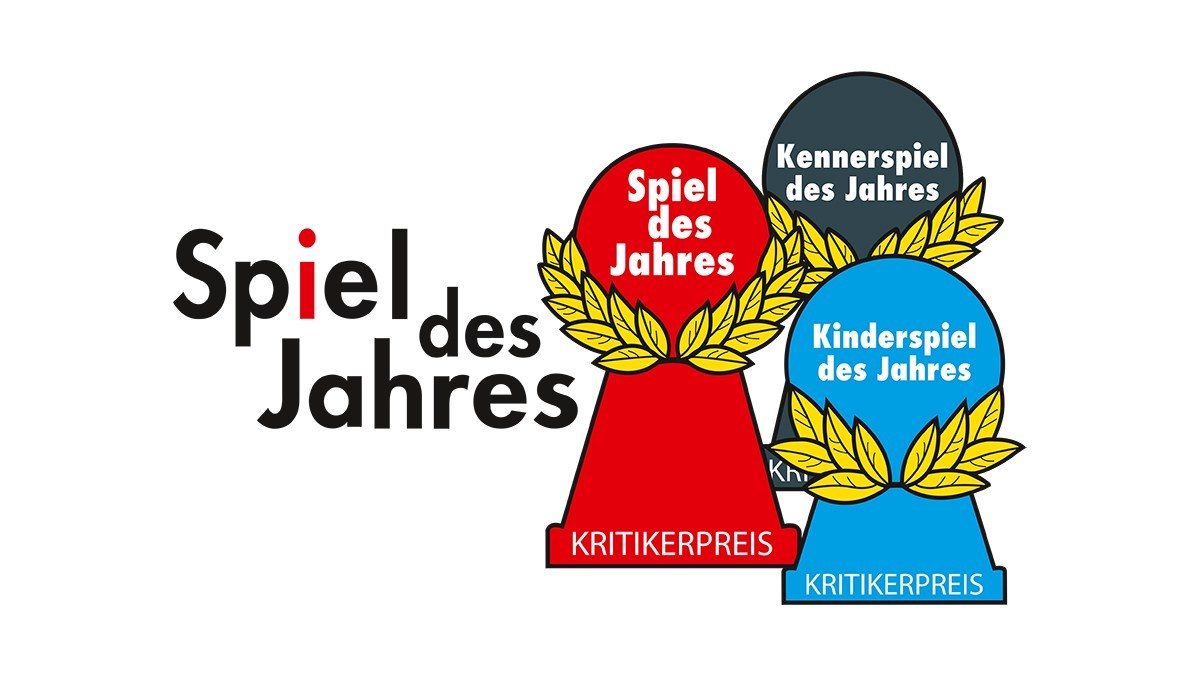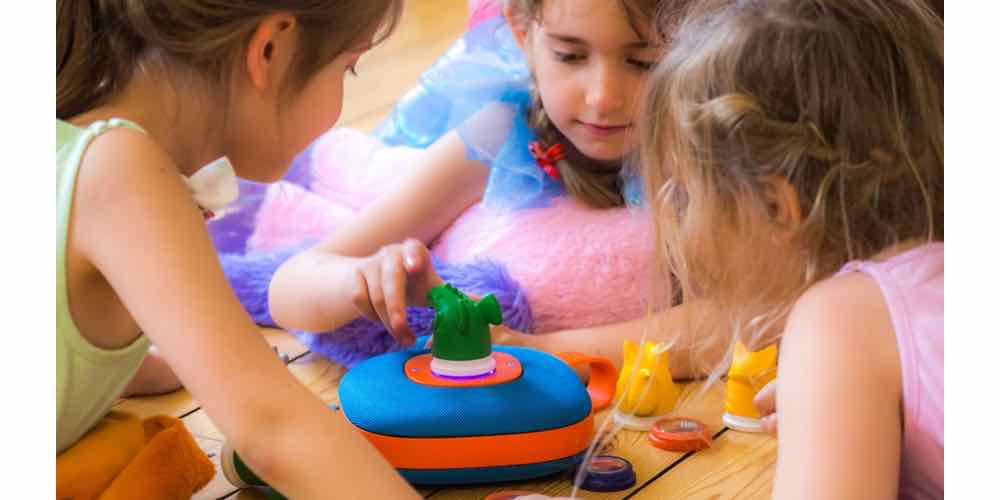The Sword of Protection was destroyed in battle, and the king has called upon you to forge a new sword. Who will create the best sword? Find out in Swordcrafters!
What Is Swordcrafters?
Swordcrafters is a game from Adam’s Apple Games about building swords for 2 to 5 players, ages 8 and up, and takes about 30 minutes to play. It’s currently seeking funding on Kickstarter, with a pledge level of $29 for a copy of the game, or $39 for the expanded edition. The game involves drafting tiles and assembling cardboard swords, and is suitable for kids and adults, as long as they’re mature enough not to whack each other with the finished swords.
New to Kickstarter? Check out our crowdfunding primer, and visit our Kickstarter curated page for more projects we love.

Swordcrafters Components
Note: My review is based on a prototype copy, so it is subject to change and does not reflect final component quality. In particular, the final game will have significantly thicker cardboard and UV coating to help it withstand wear and tear.
Here’s what you get:
- 91 Sword tiles
- Forge tile
- First Player token
- 5 Sword Hilts
- Scoring tokens
- 15 Sword Magic cards
The expanded version will also include some wild gem tiles and relic tiles, though I did not have those in my prototype so my review will not cover those.

Each sword hilt is made of four tiles: two grips and two guards, which slot together. It might be nice also to have at least one tile across the end to give it more stability. Each sword tile has two slots on either end, so that you can notch them onto the hilt and build a sword (with four sides).
The illustrations are fun: the hilt looks nice and the sword tiles have gems of various colors. The cover shows a bunch of monsters, which aren’t actually present in the core game—they show up on the relic tiles in the expanded version, but the cover seems a little odd to me simply because it doesn’t feel like it gives a very good picture of what sort of game it’s going to be.
The gems are different colors and also have different shapes, which should help with color blind players. However, some of the gems also have a gradient sort of effect, which means that the orange gem is yellow on one side, and the dark purple gem is light purple on one side … I sometimes had to look twice to make sure I was thinking of the right color.
How to Play Swordcrafters
The Goal
The goal of the game is to craft the best sword, which will be judged based on a combination of length, quality, and magic.

Setup
Give each player a hilt. Shuffle the sword magic cards and draw three at random, placing them face-up on the table. Shuffle the sword tiles and make a supply. Pick a player at random to be first player and give them the first player token.
At the beginning of the round, lay out a grid of sword tiles: 3×4 for 2 or 3 players, and 4×4 for 4 or 5 players. The forge tile (shown in the prototype photos with a picture of a sword) is always placed in the third column of the second row.

Gameplay
In turn order, each player will divide the group of tiles, separating one group of tiles into two by cutting along a straight line. You can separate a group as unevenly as you want.

Then, in turn order, each player takes one group of tiles, adding them to their swords. You must use all the sword tiles you take. If you take the forge tile, you get the first player token. (If nobody takes the forge tile—there’s always one group left over—then the first player token passes clockwise.)
Note: in a two-player game, you repeat each phase: each player will cut twice (in alternating order) and then claim twice (in alternating order).

Discard the group of tiles that was not claimed.
Then, return the forge tile to the table and set out another grid of tiles.
Game End
The game ends when there are not enough sword tiles to fill the grid. Players compare their completed swords.
First, you score according to the length of the longest side of your sword. (The prototype used 1 point per tile, but the designer told me they are tweaking this a little for the final rules.)

Then, you score for “quality”—this is the longest unbroken chain of a single color.
Finally, you score for the three sword magic cards that were revealed during setup.

Each sword magic card shows two different gem types: for instance, “Fire Storm” is red and light purple. Everyone counts up all of the gems of those two colors on their swords and compares. First place gets 9 points, second place gets 6 points, and third place gets 3 points. In case of a tie, you add point values together and divvy them up (e.g., if two players tie for first, you add 9+6=15, so each player gets 7 points). Award points for all three cards.
The highest total score wins!

Why You Should Play Swordcrafters
Okay, just look at the face in that photo above—that’s pretty much why you should play Swordcrafters. (Yes, the rulebook has a reminder that it’s not meant to be used as a sword and “could result in injury” so you really shouldn’t let your kids have a swordfight at the end of the game. Still.)
We’ll get to the actual gameplay in a bit, but building a cardboard sword is the big draw in Swordcrafters, so your reaction to that will go a long way toward determining how much you’ll like the game. It’s admittedly something of a gimmick, but it’s a fun gimmick. For kids (and adults) who like assembling things, whether that’s LEGO or puzzles or models, there’s a joy that comes from assembling things and seeing the final product, even in the case of something as straightforward as these swords.
The gameplay itself is based somewhat on that “I cut, you choose” concept, though Swordcrafters uses a different implementation than I’m used to. Instead of one player cutting and then everyone else choosing, everyone gets a chance to cut, and then everyone gets a chance to choose. The major difference is that the starting player not only gets to make the first cut, but also the first choice. So all other players are trying to make cuts that will prevent the first player from getting too much of an advantage, while not making things so terrible that they’re stuck with something they don’t want. Going last is always a bit painful, knowing that you’re going to get the worst option.
Throwing the forge tile in the mix makes things pretty interesting, though: if you’re later in turn order and you want a chance to go first (or at least advance the first player closer to you), you can try to cut things so that the forge tile is in a less desirable group. Going first often is definitely an advantage, but getting a lot of tiles is also great for both length scoring and the magic cards.

The “quality” score is a little trickier, and players going for a long string of the same color will find it a bigger challenge. Personally I think maybe it should be worth more points. The trick is that it’s not just about getting a lot of the same color gems, but getting them at the right time so that you can slot them onto the same side. Depending on the particular state of your sword, taking even one tile of the wrong color might break the chain; conversely, you may be able to take as many as four tiles of the wrong color while still keeping your chain safe.
The cutting and dividing also allows for “hate-drafting” strategies: i.e., maybe you can’t get what you want, but you can make sure nobody else gets what they want, either. It can be hard to keep track of everyone else’s sword (since you can only see two sides of it at a time) but if you know somebody has a really long chain of a particular color, you can try to place those gems in less desirable groupings.
The base game is fairly simple and fun, and I think it’s good for families and casual players who are looking for a quick game to pick up. The expanded version adds some more complexity, and may be more of a draw for those who prefer a little heavier strategy, but I can’t comment on it as much because I haven’t played that version.
Ultimately, I think it comes down to this: if the cardboard swords make you smile, then you’ll probably have fun with Swordcrafters. If you don’t like that sort of gimmick, the gameplay may not sway you, though there are some interesting choices involved during play.
For more information or to make a pledge, visit the Swordcrafters Kickstarter page!
Click here to see all our tabletop game reviews.
If you’d like to stay up-to-date with all of our tabletop gaming coverage, please copy this link and add it to your RSS reader.
Disclosure: GeekDad received a copy of this game for review purposes.







Thanks so much for the awesome coverage Jonathan. I’m glad you had fun with Swordcrafters and loved seeing the end game pictures! You rock!